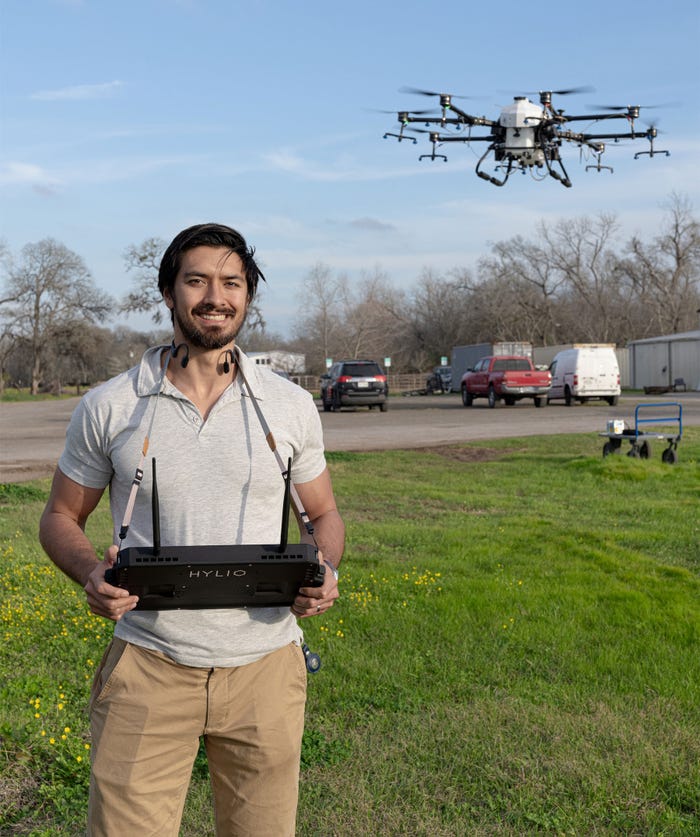April 4, 2024

A recent Federal Aviation Administration ruling, prompted by Texas-based Hylio, could pave the way for “drone swarm” farming, a potentially lower-cost method of spraying crops compared to traditional methods.
The FAA’s drone swarm rule exemption lets a single Hylio pilot simultaneously fly up to three 165-pound AG-230 drones at night. While the ruling was prompted by Hylio, it could mean a big lift for ag drone spraying everywhere, in effect putting the practice on a par with traditional ground spraying equipment.
“It’s definitely going to increase adoption of drones because you can’t just write drones off as cool for spot-spray,” says Arthur Erickson, Hylio CEO. “Now they’re a mainstay for farmers, even large row crop farmers.”
Before the approval of Hylio’s petition, a single large drone heavier than 55 pounds had to be operated by a minimum of two people — the pilot and a line-of-sight spotter — making them impractical for commercial spray operations. The exemption paves the way for greater adoption, even though it still requires line-of-sight flying.
Regulators notably considered many concerns when making their decision, including input from the National Agriculture Aviation Association, which submitted a public letter raising safety concerns for manned crop-duster pilots.
“UAS [unmanned aerial systems] performing the same mission in the same airspace present a significant hazard [to manned airplanes], particularly during seasonally busy application windows,” the letter reads.
Another letter submitted by the Small UAV Coalition offered a counter argument. “Hylio will operate its drones very close to the ground, 10 to no more than 30 feet AGL [above ground level], over predetermined, uninhabited, private, or controlled-access property. With a geo-fence boundary and operations within the visual line-of-sight of the pilot, there is little to no air risk or ground risk requiring any additional mitigation,” the letter reads.

LEADING WAY: Arthur Erickson, CEO of Texas-based Hylio, is the first drone manufacturer in the U.S. to receive “drone swarm” exemption from the FAA.
For now, the FAA’s permission extends exclusively to Hylio pilots. In the next few months, Erickson says the FAA is expected to generalize its approval through a “summary grant,” expediting similar petitions based on Hylio’s precedent-setting ruling. The swarm exemption is added to the FAA’s aerial applicator drone license, which pilots must carry to legally fly them.
“It’s a good first step, that’s for sure,” Erickson says. “Technically speaking, we’ve been able to swarm with our software [for some time], more than three drones.”
The number of Hylio drones that can be operated by one person is theoretically only limited by screen size. “Yes, the drones are autonomous,” he says. “But for safety’s sake, you want a human pilot to be able to intervene if something goes on.”
Changing regulations
For some time now, drone technology has outpaced federal rules. Regulators are trying to change that so U.S. farmers can keep up with their foreign counterparts. Many countries already allow commercial drone swarms.
An FAA statement about the ruling notes, “Current FAA rulemaking efforts are focused on developing a standard set of rules for operations beyond visual line-of-sight to make these kinds of [spray] operations routine, scalable and economically viable.”
The FAA created committee in 2021 to consider commercial drone safety implications, with specific guidelines for precision agriculture and commercial spraying.
“We are currently reviewing their [the committee’s] final report, which includes a recommendation to the FAA to establish certification and operating requirements for higher weight (in excess of 200 pounds) drones operating beyond visual line-of-sight,” the statement says. Letting pilots fly commercial drones beyond their sightline would greatly expand their usefulness.
Compared to ground sprayers, drones are much less expensive. Erickson says a swarm of Hylio drones, which range in hauling capacity from 2.5 to 18 gallons, can spray more than 200 acres per hour. The pilot defines field parameters on an interface, and then selects spray gallons per acre and flight height. “You press takeoff, and the drone goes and does it,” he says.
Once the product has been expended, the drone automatically returns to be refilled and have its batteries swapped out. Hylio’s four drones range in price from $25,000 to $80,000.
At the top-end price, “that’s enough batteries to run it back to back to back. They’re in rotation so you never run out of battery power,” Erickson says. “Let’s not forget that you could have two swarms. You could have two people out there with six drones.”
Read more about:
DronesAbout the Author(s)
You May Also Like






